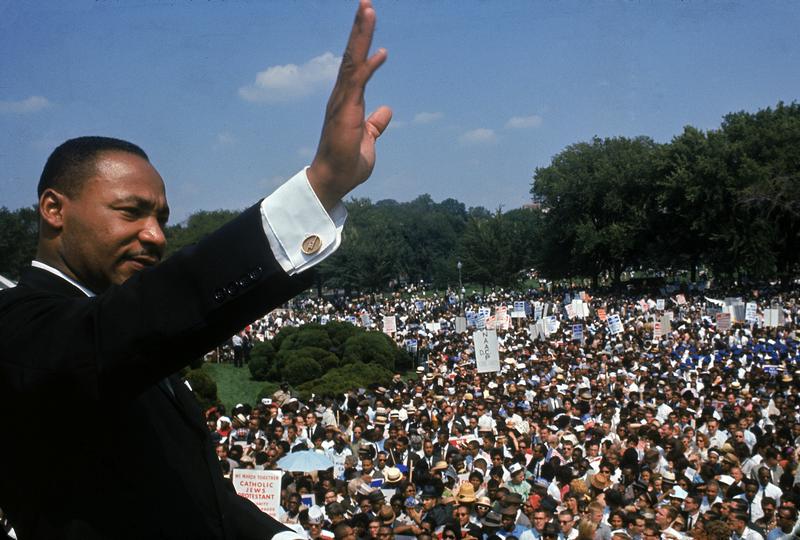The 1963 March on Washington: A Civil Rights Triumph
By | January 10, 2019

The 1963 March on Washington was a civil rights triumph that galvanized a nation, thanks to four simple words from Martin Luther King: "I have a dream."
The United States was not yet 100 years removed from the Civil War, and the old ghosts of slavery lingered in much of the country, particularly the south. African Americans faced widespread discrimination. State-endorsed segregation, in the form of Jim Crow laws, was still in place. The August 28, 1963, March on Washington for Jobs and Freedom, as the event was officially known, led directly to the passage of the Civil Rights Act of 1964 and the Voting Rights Act of 1965 -- not to mention, it was the setting for one of the most famous speeches in history.
The March on Washington remains a model of effective activism: Its organizers learned from then-recent events, planned a peaceful but attention-getting spectacle, and achieved their goals. And, of course, the event was made even more memorable and effective by Martin Luther King's "I Have a Dream" speech.

Leading up to the March on Washington
The ongoing racial discrimination and social, economic, and political repression faced by African-Americans in the United States was coming to a head. Throughout the 1940s and 1950s, various groups and individuals called for racial equality and demonstrated their views with political protests advocating for the civil rights of African Americans. The nation’s capital was the site of several protests which draw the attention of lawmakers and the media and set the stage for the 1963 March on Washington for Jobs and Freedom.

Planning the March
In the early sixties, racial tensions were heating up, and some exchanges were becoming violent. Many Civil Rights leaders, such as A. Philip Randolph, who was the president of the Brotherhood of Sleeping Car Porters, the president of the Negro American Labor Council, and the vice president of the AFL-CIO, understood that peaceful protests were more effective at swaying public opinion. Following a series of attacks on Civil Rights protesters in Birmingham, Alabama, in early 1963, Randolph and others, including Bayard Rustin, recognized the need for a large scale, peaceful protest to send a clear message to lawmakers in Washington.

Dr. King Joined the Planning
In the Spring of 1963, Randolph contacted Dr. Martin Luther King, Jr. to inform him that his group was planning a march on Washington to protest job discrimination. King agreed to join the planning and organization of the event. Soon, others were added to the planning team. They notified President John F. Kennedy of their plan to march on the capital and set the date for the event for August 28, 1963. They also set a goal for the event…they hoped the protest would culminate in a comprehensive civil rights bill. Charles McDew, the chairman of the Student Nonviolent Coordinating Committee and one of the organizing members of the march summed up the enthusiasm for the event by declaring, “Let the black laboring masses speak!”

The March on Washington Takes Place
When August 28 rolled around, more than 250,000 people…about 75% of them African-Americans…descended upon the Lincoln Memorial. Bayard Rustin welcomed the crowd and kicked off a series of speeches by prominent Civil Rights leaders. Between speeches, musical performances by such entertainers as Bob Dylan, Mahalia Jackson, Joan Baez, and Marian Anderson kept the mass of people entertained. The March on Washington closed with an address by Dr. Martin Luther King, Jr.

"I Have A Dream" Speech
Most of the other speakers wanted to give their talks earlier in the day before the media packed it in for the day. Dr. King agreed to give the last speech of the day…and what a speech it turned out to be! Standing in front of the Lincoln Memorial, King delivered his famous "I Have A Dream" speech. In it, he described his vision for a more harmonious nation, directly invoking the values expressed by the Founding Fathers. "It is a dream deeply rooted in the American dream," he said. "I have a dream that one day this nation will rise up, live out the true meaning of its creed: 'We hold these truths to be self-evident, that all men are created equal.'" The 16-minute speech is widely considered to be one of the most famous and most inspirational speeches in history.

Aftermath of the March on Washington
Following the March on Washington in 1963, Dr. King along with several other Civil Rights leaders met with President Kennedy and Vice President Lyndon B. Johnson. During the meeting, the leaders had an open discussion about the need for bipartisan support for a Civil Rights bill that would address many aspects of racial discrimination, including desegregation of public schools, protecting the right to vote, a ban on employment discrimination, and establish a means for redressing violations of constitutional rights.

The Civil Rights Act of 1964 Passes
President Kennedy’s proposed Civil Rights Act met with opposition in the Senate and ended in a filibuster. Following the assassination of Kennedy in November of 1963, President Johnson pushed for the passage of the bill, noting the legacy of Kennedy. This time, the bill passed through the Senate and the House. Johnson signed the Civil Rights Act of 1964 into law on July 2, 1964.
